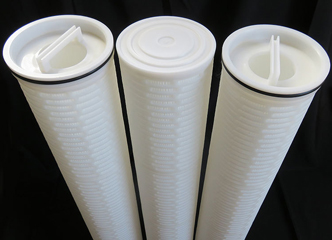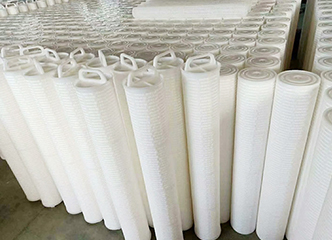In the dynamic landscape of industrial processes and fluid management, the demand for efficient and high-capacity filtration solutions has never been greater. Enter the high flow filter elements, a revolutionary innovation that has transformed the way we approach filtration. These elements are designed to handle large volumes of fluid with remarkable efficiency, offering a host of benefits and applications across diverse industries.

The development of high flow filter elements was a response to the growing need for more productive and cost-effective filtration methods. As industries expanded and processes became more complex, the traditional filtration systems often struggled to keep up with the increasing volume and velocity of fluids. High flow filter elements were engineered to overcome these limitations, providing a solution that could not only handle high flow rates but also maintain excellent filtration performance. Their significance lies in their ability to enhance process efficiency, reduce downtime, and improve the overall quality of the filtered fluids, making them an essential component in modern industrial operations.
High flow filter elements utilize a combination of depth filtration and surface filtration techniques. The filter media is composed of a porous material that allows the fluid to pass through while trapping contaminants. In depth filtration, the contaminants are captured within the internal structure of the filter media as the fluid penetrates through its thickness. This is effective in trapping a wide range of particle sizes, including smaller particles that might otherwise bypass traditional filters. Surface filtration, on the other hand, occurs as the particles are directly intercepted on the outer surface of the filter. The synergy between these two filtration methods ensures a high level of filtration efficiency, enabling the filter elements to remove impurities effectively while allowing for a significant flow of the fluid.
One of the key features of high flow filter elements is their ability to maintain a relatively low pressure drop across the filter, even when handling large volumes of fluid. This is achieved through an optimized design that maximizes the effective filtration area. The filter element is typically configured in a way that provides a large surface area for the fluid to interact with the filter media. This allows for a more even distribution of the fluid flow and reduces the resistance encountered by the fluid, resulting in a lower pressure drop. As a result, the filter can handle high flow rates without requiring excessive energy to push the fluid through, ensuring energy-efficient operation and minimizing the impact on the overall system pressure.
The heart of the high flow filter element is the filter media. It is commonly made of advanced materials such as polypropylene, polyester, or a combination of different polymers. These materials are selected for their excellent filtration properties, chemical resistance, and mechanical strength. The filter media may be pleated, wound, or otherwise structured to increase its surface area and enhance filtration efficiency. For example, pleated filter media can provide a much larger filtration surface area compared to a flat sheet, allowing for higher flow rates and longer service life. The porosity and pore size of the filter media are carefully engineered to balance the filtration efficiency and the flow capacity, ensuring that the filter can effectively remove contaminants while maintaining the desired flow rate of the fluid.
The filter element also includes a core and end caps that play crucial roles in its structure and functionality. The core provides structural support to the filter media, maintaining its shape and integrity during operation. It is usually made of a rigid material such as plastic or metal. The end caps are designed to seal the ends of the filter element and ensure a proper connection to the filtration system. They are often made of a durable material that can withstand the pressure and flow conditions of the application. In addition, some high flow filter elements may incorporate additional components such as gaskets or seals to prevent leakage and ensure a tight fit within the filtration system, further enhancing the reliability and performance of the filter.
The high flow filter element is typically housed in a suitable enclosure or housing that provides protection and facilitates its integration into the overall filtration system. The housing is designed to accommodate the filter element and ensure proper alignment and flow direction. It may also include features such as inlet and outlet ports, connection fittings, and mounting brackets or flanges for easy installation and maintenance. The mounting arrangements can vary depending on the specific application and the design of the filtration system, allowing for flexibility in installation and compatibility with different system configurations.

The most prominent advantage of high flow filter elements is their ability to handle large volumes of fluid. This makes them ideal for applications where high throughput is required, such as in large-scale industrial processes, water treatment plants, and oil and gas operations. By being able to process a significant amount of fluid in a short period, these filter elements can help to increase the overall productivity and efficiency of the system, reducing the need for multiple smaller filters or frequent filter replacements.
Despite their high flow capacity, high flow filter elements do not compromise on filtration efficiency. They are designed to effectively remove a wide range of contaminants, including particles, sediments, dirt, and other impurities. The combination of depth filtration and surface filtration techniques ensures that even small particles are captured, resulting in high-quality filtered fluid. This is crucial for protecting downstream equipment, improving the quality of the end product, and ensuring the smooth operation of the overall process. For example, in a water treatment application, high flow filter elements can remove suspended solids and impurities, making the water suitable for various uses such as drinking, industrial processes, or irrigation.
The optimized design and high-quality materials used in high flow filter elements contribute to their long service life. The large surface area of the filter media allows for more contaminants to be captured before the filter reaches its saturation point, reducing the frequency of filter replacements. Additionally, the ability to maintain a relatively low pressure drop over time helps to prevent excessive wear and tear on the filter element, further extending its lifespan. This not only reduces the operational costs associated with filter maintenance but also minimizes downtime for filter replacement, ensuring continuous and reliable operation of the filtration system.
Considering their high flow capacity, efficient filtration performance, and long service life, high flow filter elements offer a cost-effective solution in the long run. The reduced need for multiple filters and frequent replacements, as well as the lower energy consumption due to the low pressure drop, result in significant cost savings. Moreover, the improved quality of the filtered fluid can lead to fewer problems downstream, such as equipment damage or product quality issues, further reducing the overall cost of ownership. In addition, the ease of installation and maintenance associated with these filter elements also contributes to their cost-effectiveness, as they can be integrated into existing filtration systems with minimal modifications and require less labor for upkeep.
In the water treatment industry, high flow filter elements are widely used in various processes, including pretreatment, filtration for municipal water supply, and industrial water treatment. They are essential for removing contaminants from raw water, such as sediments, particles, and organic matter, before further treatment steps such as reverse osmosis or disinfection. High flow filter elements help to ensure the quality and safety of the treated water, protecting downstream equipment and ensuring compliance with water quality standards. They are also used in wastewater treatment plants to remove solids and impurities from the wastewater, facilitating the treatment process and reducing the environmental impact.
The oil and gas industry relies on high flow filter elements for filtration in upstream, midstream, and downstream operations. In upstream operations, they are used to filter out impurities from drilling fluids, ensuring the smooth operation of drilling processes and protecting the drilling equipment. In midstream, they are employed in pipeline transportation to remove contaminants that could cause corrosion or damage to the pipelines. In downstream, high flow filter elements are used in refining processes to purify feedstocks and ensure the quality of the final products such as gasoline, diesel, and lubricants. Their ability to handle high flow rates and withstand the harsh conditions of the oil and gas industry makes them an indispensable part of the filtration process.
In the chemical processing industry, high flow filter elements are used to filter chemicals, solvents, and slurries. They help to remove impurities that could affect the quality of the chemical products and the performance of the processing equipment. For example, in the production of pharmaceuticals, high flow filter elements are used to ensure the purity of the drug substances and the integrity of the manufacturing process. They are also used in the production of paints, coatings, and other chemical products to remove contaminants and achieve the desired product quality. The chemical resistance of the filter media used in high flow filter elements makes them suitable for handling a wide range of chemical substances.
The food and beverage industry requires high-quality filtration to ensure the safety and quality of its products. High flow filter elements are used to filter water, juices, and other liquids used in the production process. They help to remove bacteria, yeast, molds, and other contaminants, preventing spoilage and ensuring compliance with food safety regulations. In addition, high flow filter elements are used in the filtration of process fluids such as cleaning solutions and lubricants to prevent cross-contamination and maintain hygienic conditions in the production facility. Their ability to handle high flow rates is essential in the food and beverage industry, where production volumes are often large and continuous operation is required.
High flow filter elements have emerged as a game-changer in the field of filtration, offering a combination of high flow capacity, efficient filtration performance, long service life, and cost-effectiveness. Their innovative design and advanced materials have made them a preferred choice in a wide range of industries, from water treatment and oil and gas to chemical processing and food and beverage. As technology continues to advance, we can expect further improvements in the performance and functionality of high flow filter elements, enabling them to meet the ever-increasing demands of modern industrial processes. Whether it is ensuring the quality of our water, powering our industries, or safeguarding the safety of our food and beverages, high flow filter elements are playing a crucial role in enhancing filtration efficiency and contributing to a more sustainable and productive future. With their numerous advantages and diverse applications, high flow filter elements are set to continue revolutionizing the filtration landscape for years to come.












